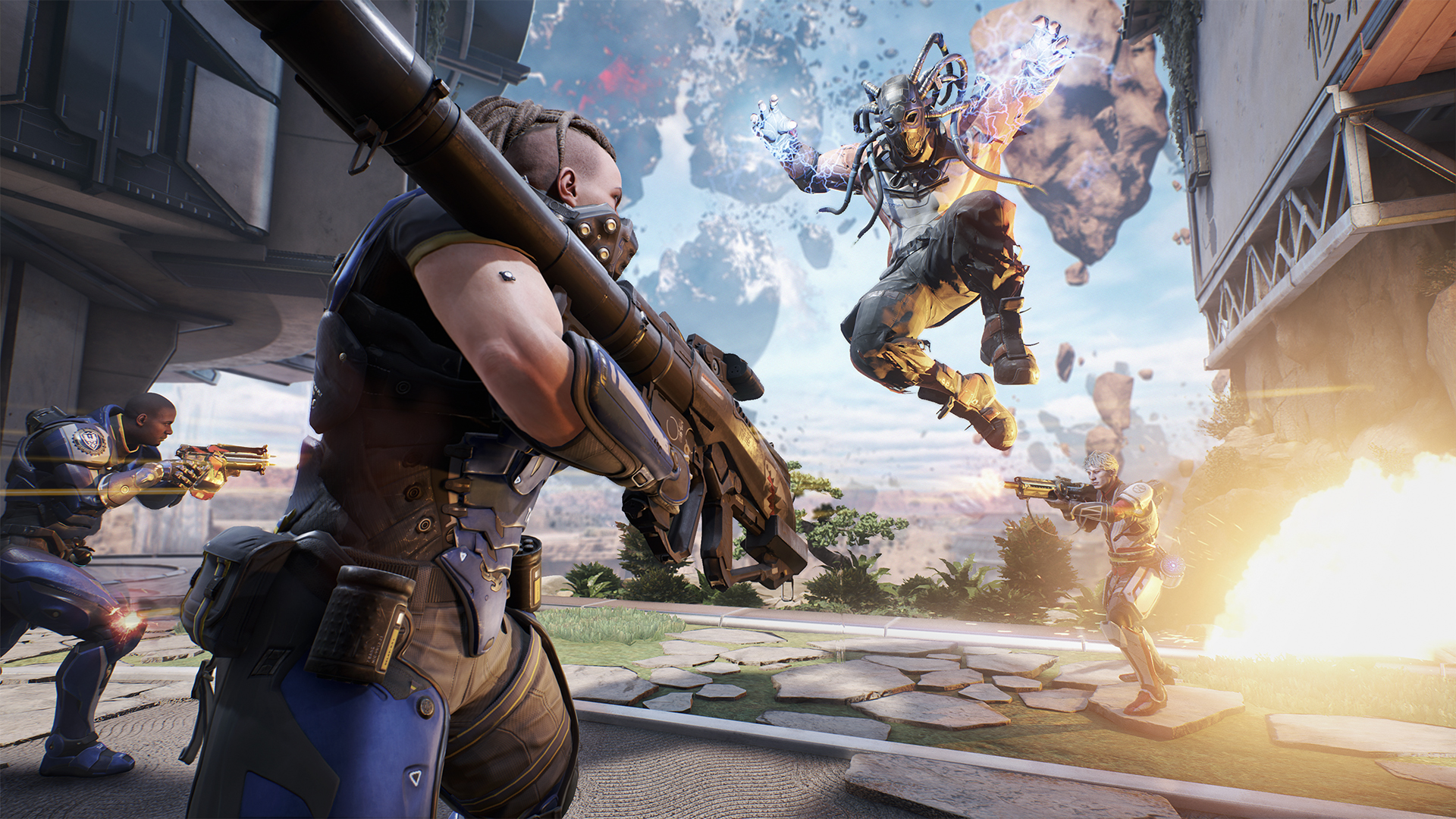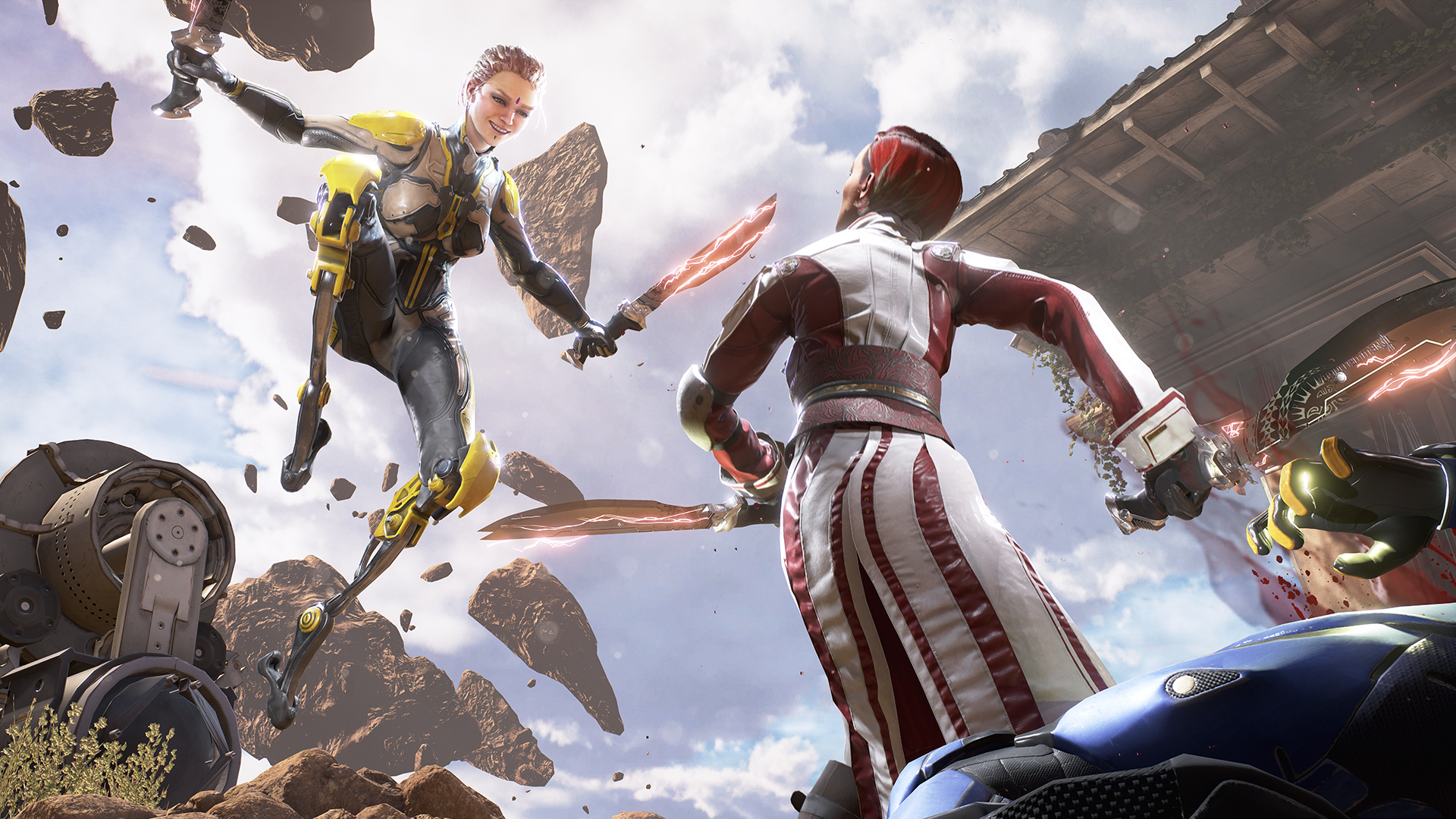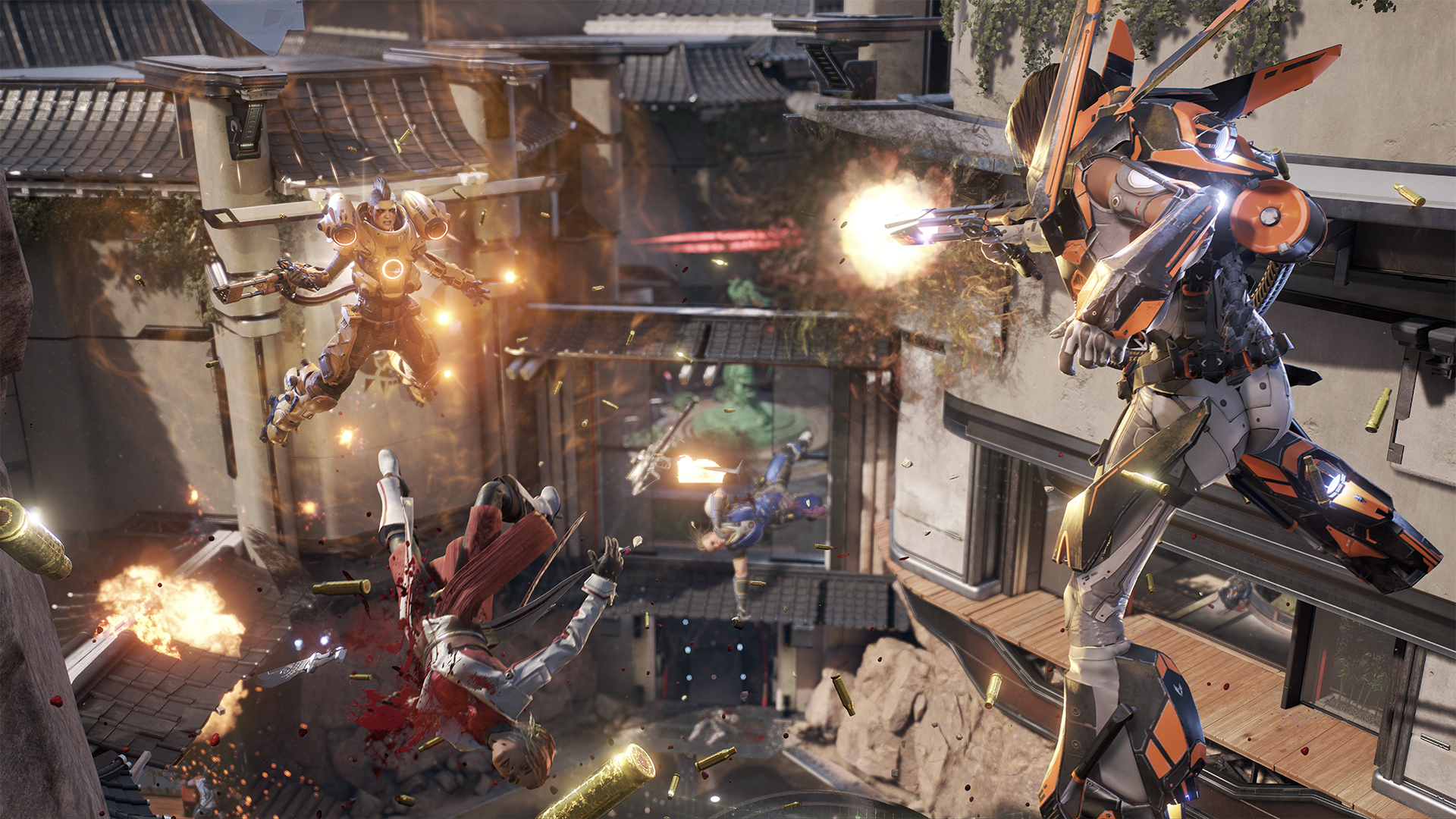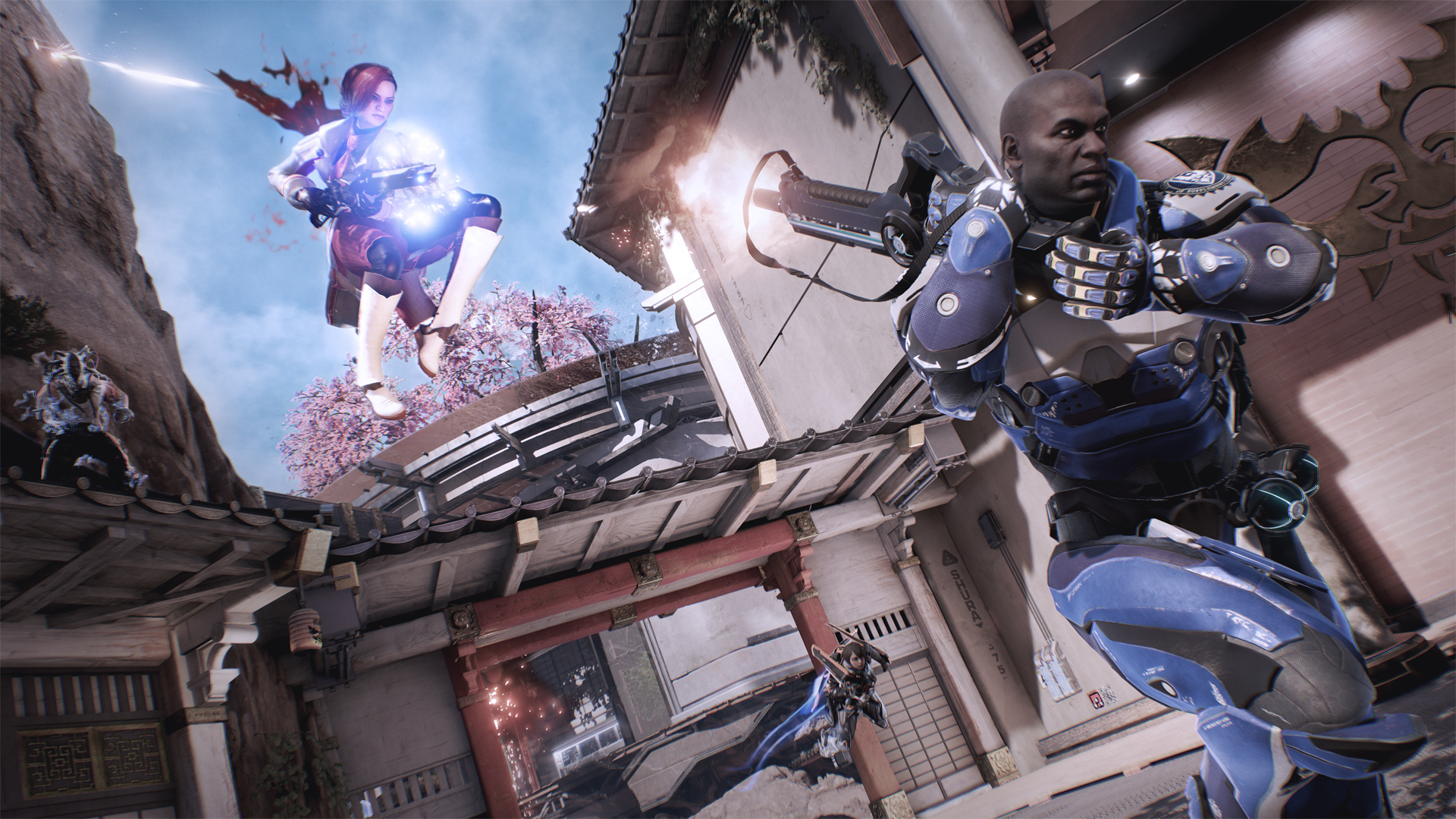LawBreakers revealed: a tornado of guns, gravity, and the f-word


Boss Key Productions was founded by Cliff Bleszinski and Arjan Brussee, who developed Jazz Jackrabbit together in the '90s. Bleszinski stayed with Epic Games, working on the Unreal series and Gears of War, while Brussee helped lead Killzone developer Guerrilla Games.
Cliff Bleszinski keeps calling LawBreakers “mature.” His characters aren’t League of Legends’ fantasy hodgepodge—which he laughs about, suggesting cosplay is informing design in that case—or Overwatch’s likable cast of Pixar fighters. This is Cliff Bleszinski, the Unreal Tournament and Gears of War guy. His characters are mad and violent and one of them has electricity coming out of his face. They say swears.
Truly, LawBreakers is just as goofy as any other shooter coming out right now (the trailer above elaborates), just not as smiley. It’s videogame-gritty, exaggerated and splattered with blood. It’s a silly but sensible direction: cartoon colors are in right now, so Bleszinski wonders if the green-and-brown era Gears of War spawned in isn’t due for a comeback. Maybe it is, but what’s more important to me is that I had a lot of fun playing it.
I played five early alpha rounds of LawBreakers (see one of those rounds in the video embedded below) with press on a recent trip to Bleszinski’s studio, Boss Key, and was surprised I picked it up so fast and enjoyed it so much, given that I’m not all that hot for other nouveau multiplayer shooters like Overwatch. It isn’t entirely unlike that game, though, with a classic team shooter core that’s been dipped in modernity: character-based classes with special abilities whose cooldown timers leave a not unpleasant MOBA aftertaste.
Cruising altitude

The teams in LawBreakers are the Law and the Breakers (a bit on the nose, eh?). They have different characters, but those characters share identical classes, so there's no difference aside from names and looks. Here are the four classes that were available when I played.
Titan: Bomchelle (Law), Chronos (Breakers)
A rocket launcher, lightning rifle, and big dash and slam attack make Titan-class characters good base defenders. They can also slow enemies and go into a force lightning-like rage.
Enforcer: Axel (Law), Kintaro (Breakers)
Your balanced attacker/defender. The enforcer carries an assault rifle, shock pistol, and can speed up movement, reloading, and shooting for herself and nearby allies. The class is topped off with HUD-distorting electromagnetic grenades and an ultimate that fires lock-on missiles.
Assassin: Hellion (Law), Kitsune (Breakers)
The coolest class, assassins can zip around via grappling hook with dual machetes. A secondary shotgun punishes opponents who try to kite her, while her Flux Blast abiliy knocks back enemies. Her ultimate ability, Frenzy, shows enemies through walls and regenerates health with each kill.
Vanguard: Maverick (Law), Toska-9 (Breakers)
My favorite class, Mavericks run with a primary gatling gun and secondary palm-blast of energy. Combined with her afterburners, her Pulsar blasts make her very maneuverable in low-G, which her ultimate Starfall attack creates a pocket of after she slams into enemies on the ground.
The special movement abilities are the best blend of old and new. I was first discouraged, then excited to find that the shift key doesn’t sprint, tossing out my left pinky’s years of training. There’s no generic sprint action at all: rather, each character has a different high-speed movement ability. The hulking rocket launcher guy charges forward and slams his fists down, but otherwise plods along like a sousaphonist. The assassin sweeps along the edges of the floating map in wide arcs, pivoting from a grappling hook. The vanguards fire afterburners to burst forward, flying inches off the ground for as long as their fuel lasts (it recharges when not in use), and can also shoot bursts of energy from their palms to air-punch opponents or blast off the ground like Iron Man for a vertical leap.
Shooters that are excited about movement are shooters I’m excited about, and LawBreakers loves it. The small, arena-style setup doesn’t set it down next to Tribes on that front, but it similarly encourages the discovery of unique routes and the use of tricky maneuvers. The characters aren’t very fast on their own, but precise application of their abilities makes them go fast (they gotta), and I was bouncing around, dodging, feinting, flitting in and out of danger—or at least, I sensed I could do all that if I spent more time practicing. As the assassin especially, I tended to gracelessly fall off the map more than grapple around poles like the deadly tetherball I know she can be.
To be fair, I was also getting to grips with LawBreaker’s gravity problems. The moon exploded or something—that’s not important—and now pockets of low-gravity space facilitate game design everywhere. In the gravity-free center of the map we played on just a few taps of my vanguard’s afterburners would send her arcing toward the upper level of the enemy base. Additionally, and this is most fun with rocket-launcher wielding titans, the left control key fires your weapon backwards for extra propulsion, and maybe a kill if you’re lucky.
The team bases on the map I played on have regular gravity, but pockets of distorted space can also balloon out of special abilities to disorient and slow enemies. The vanguard’s ultimate ability—the one with the longest timer, that is—fires her into the air, then gives you a few seconds to target a cluster of enemies on the ground and rocket into them. After the explosion, a small low-G sphere pops open, sending your enemies’ shaken bodies drifting away from the blast. A light spray from her gatling gun finishes them off while they’re still trying to figure out which way is up. Used well, it feels like a choreographed sequence. If doing it over and over again will always be fun, I don’t know, but I was always pumped when the ability’s hotkey icon lit up.
The biggest gaming news, reviews and hardware deals
Keep up to date with the most important stories and the best deals, as picked by the PC Gamer team.

Low battery
The mode we played is similar to capture the flag, but not quite: there’s a single battery that spawns in the center of the level, and both teams, Law and Breakers, are trying to charge it up at their bases. Fully charging the battery initiates a countdown, at which point the other team must steal it off the enemy charger or forfeit a point. If the battery is stolen, though, it retains its charge. One team can spend the whole round in possession, filling the battery to 100 percent before losing after a clutch steal. It’s very intentionally designed to create those moments, and it works—every battle felt like it came down to the last second.
Every battle felt like it came down to the last second.
Respawn times are long enough to matter—from a few seconds to over 10—and movement speed isn’t all that fast unless you start burning your special ability (they all recharge, but it takes time), so kills don’t feel futile. Wipe out three or more players defending the enemy base and you’ve got time to snag the battery and jet into the map’s low-gravity center where you’re much harder to hit.
The guns aren’t something I can speak about in depth, given that I didn’t have a lot of time to assess them. The titan’s rockets act like we know rockets to act, requiring keen timing and the decision to go for splash damage or a direct gut shot (and the character models really bust open, as if telefragged). Titans also have a secondary lightning gun-style weapon—still a good time after several shooter iterations—while other characters have some pairing of more traditional weapons with sci-fi twists, like an assault rifle with a spherical magazine. The only characters who currently grip melee weapons as their main are the machete-wielding assassins. I couldn’t quite get the hang of it or the grappling hook, but I was very satisfied when I did manage to zip into range and slice a guy into quarters.
Those melee kills aside, the characters are generally spongy, but the longer time-to-kill facilitates extended duels and encourages mixing up abilities. Vanguards, for instance, can throw a handful of high-damage contact grenades that are great for ending fights without having to reload. Or I might get in a couple seconds of sustained gunfire followed by a blast from her hand jet to splat gibs on the wall. Timing and targeting a special ability for the kill is always more satisfying than taking down an opponent by spitting regular old bullet holes through them.
The death animations are worth talking about: I had a brief behind-the-scenes look at how the programmers merge animations and ragdoll physics to really double-down on Bleszinski’s brand of ‘maturity.’ If your finishing blow goes to the leg, for instance, it’ll kick out and the character will flop to the ground face first, or fly off into a zero-G grave leaving a trail of blood globules.
I’m pleased by silly chunks of gore, and a little humbled by the work the Boss Key team presented during my studio tour. Play games long enough and you start to get the sense that you know what they take to make, but I’ve never considered how to design a lighting system that ensures all characters, with their different shapes and outfits, are equally visible in dark parts of the map, or what FPS movement should look like in zero-G from the perspective of an observer who needs to know which way their opponent is moving and aiming. Boss Key aimed to impress with its behind-the-scenes look, and it did, revealing the sorts of details I might gloss over while playing a game but would absolutely notice the absence of.

Changing minds
Another design problem I’ve never considered the solution to, more understandably, is how to turn James Bond into the devil. Bleszinki’s staff doesn’t need prompting to have a laugh at their boss’ creative methods: concept artist Jay Hawkins explains to my tour group that after prototyping a fashionable spy character, Bleszinski suddenly decided the character should have goat horns. So with much reworking, the Bond character became a devil character on the Breakers side, with a cybernetic visor in the shape of horns (so that it fits into the fiction and isn’t just a guy with goat horns). That meant, of course, that an angel was in order on the Law side. “Wings don’t make sense,” says Hawkins, describing them as his “nightmare” while explaining the difficulty of designing cyber-feathers that look functional but don’t actually function, as the character has no flying abilities.
Bleszinski suddenly decided the character should have goat horns.
Trying ideas and tweaking them or throwing them out when they don’t work is part of the process. Another recent change to LawBreakers, for instance, is the business model. While it was originally going to be free-to-play, Bleszinski spoke at GDC 2016 about the frustration of considering monetization plans with every design decision. It was getting in the way, he says, so LawBreakers will instead take a buy-to-play model, similar to Counter-Strike: Global Offensive. When I ask Bleszinski if he plans to sell extras later on—new characters, maps, maybe in one of the season passes EA likes to announce months before its shooters ship—his answer is no, he won’t segment the players. Cosmetic items may be sold, but any new maps or characters will be free updates. And LawBreakers won’t be a $60 game.
“I think what you’re seeing, and you’re going to continue to see, is a massive shift in the multiplayer game arena, where it goes from $60 multiplayer games that kind of limped along at retail with tons of DLC to games that are kind of mid-range price, more impulse buy,” says Bleszinski. “I look at games like—great games like Titanfall and Evolve to be fair, but I just don’t think they should’ve come out on disc at $60.”

Like a lot of other games today, though, LawBreakers will start its public life as an alpha. Bleszinski won’t confirm the definite plan, but he’s keen on the idea. “Is this the Early Access question?” he asks before I’ve actually said the words. “I mean, more and more people keep doing it for a reason, because a lot of triple-A games, they hit day one and they facepalm, because you’re basically issuing a denial of service attack on all their servers.”
What we know now is that Boss Key is taking signups for the chance to participate in a series of alpha tests, though dates for those tests are unconfirmed. Based on my session, LawBreakers feels ready for that sort of free pre-release access. The interface and HUD are clean and readable, I didn’t encounter any bugs, and the four classes feel like enough to play with in the short term. Then again, I played a very controlled preview build—who knows what could go wrong in a wide release?—and I don’t know how much more beyond the one map and one mode I saw is ready.
The recognizable, comfortable fun of Unreal Tournament can have a hotbar and still respect movement and accuracy.
So far, LawBreakers has demonstrated to me that the recognizable, comfortable fun of Unreal Tournament can have a hotbar and still respect movement and accuracy. My big questions now center around the characters and maps: how will relationships form between characters and their counters, as in the web of checks and cross-checks Team Fortress 2 has sewn? How creative will the maps be with gravity, and how creative can they be before they’re too complex? What will be the one map that defines LawBreakers?
I didn’t have time to ask Bleszinski every question in my head, but we’ll likely have more answers soon. LawBreakers will be playable at PAX East this week, and it already has a Steam store page with a ‘Summer 2016’ release. Whether that release will be in Early Access or not is yet to be determined. Whenever it’s out, though, I’m confident that LawBreakers can challenge its cute and colorful competition. Not so much with blood and cursing—I actually wish the mean-ass characters were more endearing—but with grappling hooks, afterburners, and low-gravity no-look behind-the-back headshots.

Tyler grew up in Silicon Valley during the '80s and '90s, playing games like Zork and Arkanoid on early PCs. He was later captivated by Myst, SimCity, Civilization, Command & Conquer, all the shooters they call "boomer shooters" now, and PS1 classic Bushido Blade (that's right: he had Bleem!). Tyler joined PC Gamer in 2011, and today he's focused on the site's news coverage. His hobbies include amateur boxing and adding to his 1,200-plus hours in Rocket League.

